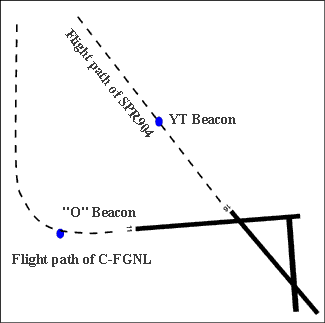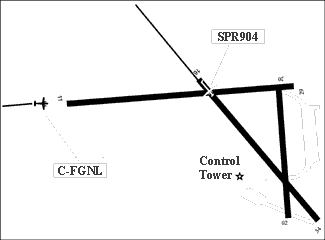Loss of separation
Between
Newfoundland Government Air Services
Beechcraft King Air A-100 C-FGNL
and Provincial Airlines Limited
Fairchild SA227AC C-FIPW
St. John's, Newfoundland
The Transportation Safety Board of Canada (TSB) investigated this occurrence for the purpose of advancing transportation safety. It is not the function of the Board to assign fault or determine civil or criminal liability. This report is not created for use in the context of legal, disciplinary or other proceedings. See Ownership and use of content. Masculine pronouns and position titles may be used to signify all genders to comply with the Canadian Transportation Accident Investigation and Safety Board Act (S.C. 1989, c. 3).
Summary
C-FGNL, a medical evacuation (MEDEVAC) flight, was inbound on an instrument flight rules (IFR) flight plan to St. John's, Newfoundland, for a landing on runway 16.C-FIPW, also on an IFR flight plan and operating as Speedair (SPR) 904, was approximately 12 miles behind C-FGNL and also planning to land on runway 16. Approximately 33 miles from the St. John's airport, the pilot of C-FGNL requested and received radar vectors for an approach to runway 11.
A loss of separation occurred when Speedair 904 landed on runway 16 at the same time that C-FGNL was on short final for landing on runway 11. The distance between the two aircraft was 1.4 nautical miles (nm) when the required radar separation was 3 nm.
Ce rapport est également disponible en français.
Factual information
The 2200 Newfoundland daylight saving time (NDT) surface actual weather for St. John's was as follows: indefinite obscured ceiling at 100 feet, visibility three-eighths of a mile in light drizzle and fog, temperature and dew point 3°C, wind 160° magnetic at 15 knots. The runway visual range (RVR) for runway 16 was 2,000 feet with the light setting on strength 5, and 2,200 feet on runway 11 with the light setting on strength 5.
Initially, both aircraft were being controlled by a Gander Centre controller who had been licensed as a low domestic controllerFootnote 1 for two years. In his planning, the controller anticipated that C-FGNL would land on runway 16 ahead of SPR 904. C-FGNL was cleared for an approach for runway 16 upon interception of the localizer; however, the pilot, after receiving the RVR for runways 16 and 11, requested a clearance for an approach on runway 11. The controller then cancelled C-FGNL's approach clearance for runway 16 and issued radar vectors to C-FGNL for an approach for runway 11.
At that time, the controller determined that the extra distance required for C-FGNL to reach the final approach for runway 11 would allow SPR 904 to land ahead of, but not delay, C-FGNL. SPR 904 was advised to keep the speed up. SPR 904 was then cleared for the instrument landing system (ILS) approach to runway 16 and instructed to contact St. John's tower.
The controller was then relieved by a second (relief) controller who had 25 years experience as a low domestic controller. The relief controller was briefed by the first controller about the possible traffic conflict developing between SPR 904 and C-FGNL.
The pilot of SPR 904 reduced airspeed upon interception of the localizer. The relief controller issued the following to C-FGNL: "GNL reduce to approach speed please. There's a speedair ..ah..8 miles final for runway 16". C-FGNL was about one mile from intercepting the localizer final for runway 11 when the relief controller issued the speed reduction and was six miles on final approach when cleared for the straight-in ILS approach on runway 11 and instructed to contact St. John's tower (YT-TWR).
| COMMUNICATION TRANSCRIPT SHORT FINAL | ||
|---|---|---|
| Time | Agency | Communication |
| 19:54:42 | C-FGNL | And ah..GNL confirm we are cleared to land. |
| 19:54:44 | YT-TWR | Golf November Lima, Tower. Negative. Merlin traffic about 2 miles back on approach for runway 16. |
| 19:54:50 | C-FGNL | GNL. |
| 19:55:18 | YT-TWR | Golf November Lima, Tower. That Merlin traffic is a mile final for runway 16. Expect landing clearance on short final. |
| 19:55:27 | C-FGNL | GNL Medevac; understood. |
| 19:55:30 | YT-TWR | Speedair 904 advise when you are through the intersection runway 11. |
| 19:55:32 | SPR 904 | 904. |
| 19:55:56 | C-FGNL | GNL is at minimums. What are we going to do. Over. |
| 19:55:58 | SPR 904 | Through the intersection for 904. |
| 19:55:59 | YT-TWR | Golf November Lima, cleared to land runway 11. |
| 19:56:00 | C-FGNL | GNL's landing. |
The Aeronautical Information Publication (A.I.P. Canada), RAC section 3.15.10 (b), addresses the use of the flight plan prefix "MEDEVAC." This section states that the term MEDEVAC is to be inserted in the flight plan when the operation is a medical evacuation flight responding to a medical emergency for the transport of patients, organ donors, organs, or other urgently needed life-saving medical material. Air Traffic Services will give priority to flights so designated. Note (1) states that discretion must be practised in the use of the term "MEDEVAC" as it is intended only for that portion of a flight requiring a priority as dictated by the medical requirement.
All flights undertaken by C-FGNL for the purpose of medical evacuation are classified by the operator as a MEDEVAC and the term "MEDEVAC" is used on all flight plans. However, it was determined during the investigation that some of these flights are responding to a non-critical patient transfer rather than medical emergencies.
The purpose of the occurrence flight was to pick up an infant, who was diagnosed with apnea episodes, in St. Anthony and transport her, a medical escort, and one other person to St. John's. The first leg of this flight, from St. John's to St. Anthony, was delayed leaving St. John's for about two hours because the aircraft was waiting for two non-priority passengers. However, the flight plan indicated that this portion of the flight was a "MEDEVAC".
The Air Traffic Control Manual of Operations (MANOPS), section 532.1 (B), states that three miles separation between aircraft is required provided:
- terminal control services are being provided;
- a maximum range of 60 miles is displayed on the radar display; and,
- altitude readouts for both aircraft are displayed; or
- both aircraft are at or below 15,000 feet asl.
All of the above requirements were being met in this instance.
Both of the controllers indicated that a high degree of priority is placed on an aircraft utilizing the MEDEVAC status. The option was available to the relief controller to issue an alternative clearance to either aircraft to maintain required separation; however, this was not done. He stated that he was willing to accept the loss of separation and the consequences it would bring rather than delay the MEDEVAC flight by having it conduct a missed approach. The controller was monitoring the flights on radar, and he was confident that there would be no risk of collision.
Analysis
The first controller was aware of the developing conflict between the two aircraft. He requested that SPR 904 keep his speed up, and he assumed that this increase in speed, along with the extra distance that C-FGNL had to fly to get to the approach for runway 11, would provide adequate, yet minimum, separation. He did not anticipate that SPR 904 would reduce his airspeed upon interception of the localizer, thereby reducing the separation between the two aircraft. The relief controller took over the position prior to SPR 904 reducing speed. He saw a loss of separation developing, but did not take action to prevent it.
The term MEDEVAC on a flight plan has a significant impact on the air traffic control system in that air traffic controllers give priority handling to these aircraft and do everything possible to avoid delays. In this occurrence, both controllers were aware that C-FGNL was a MEDEVAC, and they assumed that priority handling was required. Based on the assumption that the MEDEVAC was a priority, the relief controller was willing to accept the loss of separation that resulted, rather than issue an alternative clearance to either aircraft.
Findings
- C-FGNL's flight plan indicated that the flight was a MEDEVAC, even though priority handling was not required.
- The relief controller allowed the separation between the two aircraft to be reduced to 1.4 nm when 3 nm was required.
- The relief controller consciously allowed a loss of separation rather than issue an alternative clearance to either aircraft.
Causes and contributing factors
The developing conflict and subsequent loss of separation between the two aircraft was detected but not resolved by the relief controller. Contributing to the occurrence was the willingness of the controllers to accept the loss of separation in order to give priority handling to a MEDEVAC.
Safety action
Safety action taken
Information regarding the use of the term "MEDEVAC" on flight plans when it is clear that the flight does not require high priority was sent in July 1996 to Transport Canada and others involved with this occurrence.
This report concludes the Transportation Safety Board's investigation into this occurrence. Consequently, the Board, consisting of Chairperson Benoît Bouchard, and members Maurice Harquail and W.A. Tadros, authorized the release of this report on .

